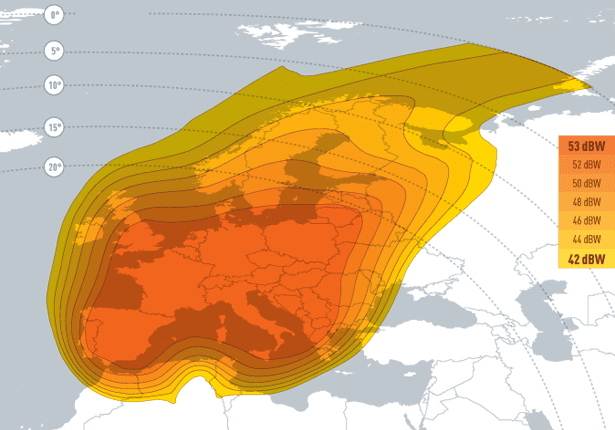COSPAR ID 2002-035A Mission duration 17 years (anticipated) Launch mass 4,050 kg Rocket Ariane 5 | SATCAT no. 27460 Launch date 5 July 2002 Launch mass 4,050 kg Launch site Guiana Space Centre | |
 | ||
Similar Hotbird 13E, Eutelsat W3A, Telstar 12, NSS‑7, Eutelsat 10A | ||
Comment capter facilement n importe quel satellite all recivers
Eutelsat 5 West A, formerly Atlantic Bird 3 (or AB 3) is a communications satellite belonging to the operator Eutelsat. Situated at 5° west, it broadcasts satellite television, radio and other digital data. Developed for France Telecom it transferred soon after its launch to the operator Eutelsat. It entered operational service in early September 2002. Its current anticipated working life is 17 years.
Contents
- Comment capter facilement n importe quel satellite all recivers
- Eutelsat 5 west a 5 w fta
- History
- Technical characterisitics
- French public analogue
- French public digital
- Regulatory obligations for the FRANSAT bouquet
- Chronology
- References
Eutelsat 5 west a 5 w fta
History
Stellat 5, as it was originally known, was built by Alcatel Space on behalf of Stellat, a joint-venture between France Telecom (70%) and Europe*Star (30%), a subsidiary of Alcatel Space and Loral Space and Communications. It was launched 5 July 2002 at 23:21 UTC by an Ariane 5 G rocket from Guyana Space Centre along with the Japanese satellite N-STAR c. It had a launch weight of 4,050 kilograms (8,930 lb). Victim of financial difficulties, France Télecom withdrew from space operations. In this move it sold Stellat to Eutelsat in July 2002. Early 7 March, the satellite entered operational service. On the 25, Eutelsat completed the acquisition for a sum of €183,900,000 and renamed the satellite Atlantic Bird 3.
AB 3 took on the role covered by the satellites Telecom 1 and 2 C, operational between 1983 and 2002, in the historic French position of 5° longitude West. In March 2012 Eutelsat re-baptised its satellite fleet, and AB 3 was renamed Eutelsat 5 West A.
Technical characterisitics
Atlantic Bird 3 was assembled by Alcatel Space, later Alcatel Alenia Space, on a Spacebus 3000 3B platform. It was equipped with 35 Ku band repeaters covering Europe, North Africa and the Middle-East as well as 10 C band repeaters. The Ku band repeaters are 94 W. The 12 C band repeaters, 55 W, though only 10 can be simultaneously active.
During the eclipse of the spring 2004 equinox, the satellite lost 6 of its total of 108 battery elements, reducing its performance.
French public analogue
Atlantic Bird 3 was launched to replace satellite Telecom 2C. It therefore took on the mission to continue the transmission of French national analogue TV channels to:
In France, Atlantic Bird 3 enabled Eutelsat to serve 1.6 million households (of nearly 23 million with televisions) who otherwise did not receive a signal at all, or who received a poor or unreliable signal ("snow", echos, interference, fog, repeated storm damage of mountain transmitters). No other free alternative existed. Transmissions were made in SÉCAM, the standard used in France.
Reception of analogue satellite TV can be achieved with relatively basic equipment:
Terrestrial analogue transmissions ceased in France 29 November 2011 and the analogue satellite service reduced accordingly thereafter.
French public digital
With the arrival of digital terrestrial television in France, notably 18 or 19 free national channels attributed by the CSA, this satellite was chosen to feed terrestrial transmitters from March 2005. Householders could also use AB3 to receive French digital TV: Télévision Numérique Terrestre (TNT) :
Hybrid Analog / digital demodulators have permitted continued access to free-to-air national channels during the transition. Since the end of 2011 and the termination of analogue broadcasting on Atlantic Bird 3, now requires a subscription to one of the two packages present on the satellite or a Fransat labelled terminal.
The various packages offering bouquets of digital channels are:
The terminals compatible with these bouquets employ MPEG-2 or MPEG-4 (thus backwards compatible with 2) for encrypted broadcasts.
Regulatory obligations for the FRANSAT bouquet
In the 2007 bill "the future of television" French senators voted for an article requiring national digital TV broadcasters to make their free-to-air channels available to viewers via at least one satellite distributor or channel editor within a maximum period of three months from the date of enactment of the law confirmed by the vote of Deputies. This law passed through a fixed joint commission of 2 chambers, because the text was amended and adopted permanently. The PS group that had challenged before the Constitutional Council was dismissed on 28 February 2008.
In a report published by the Secretariat of State for Strategic Studies, it was planned to create a 2nd free satellite offer to over 1.5 million households already facing Atlantic Bird 3 without redirecting their existing satellite dish, in addition to the TNTSAT offer managed by the Canal+ Group. Announced on 8 February 2009 by Eutelsat, this offer designated FRANSAT joined AB3 in June 2009.
